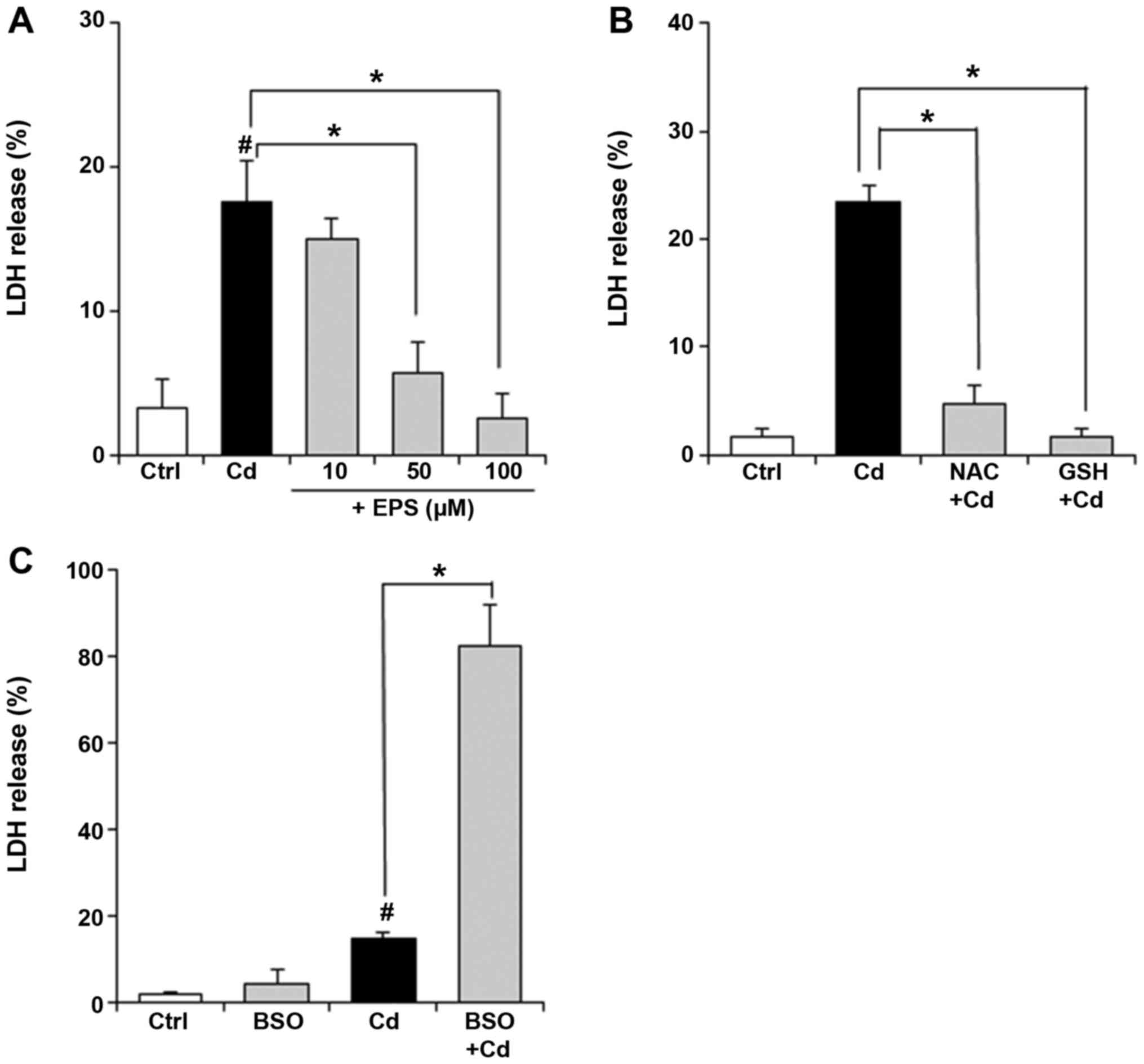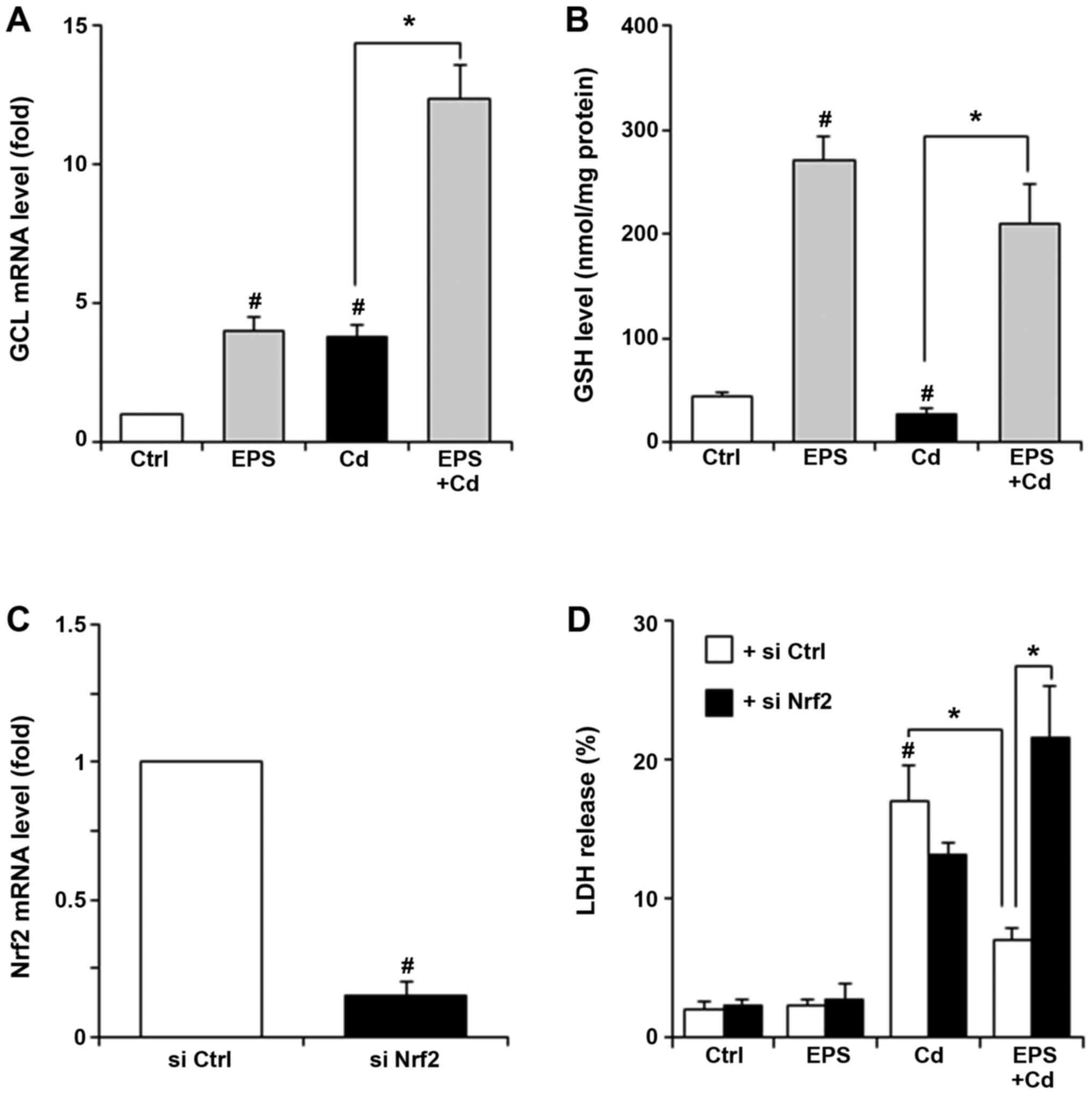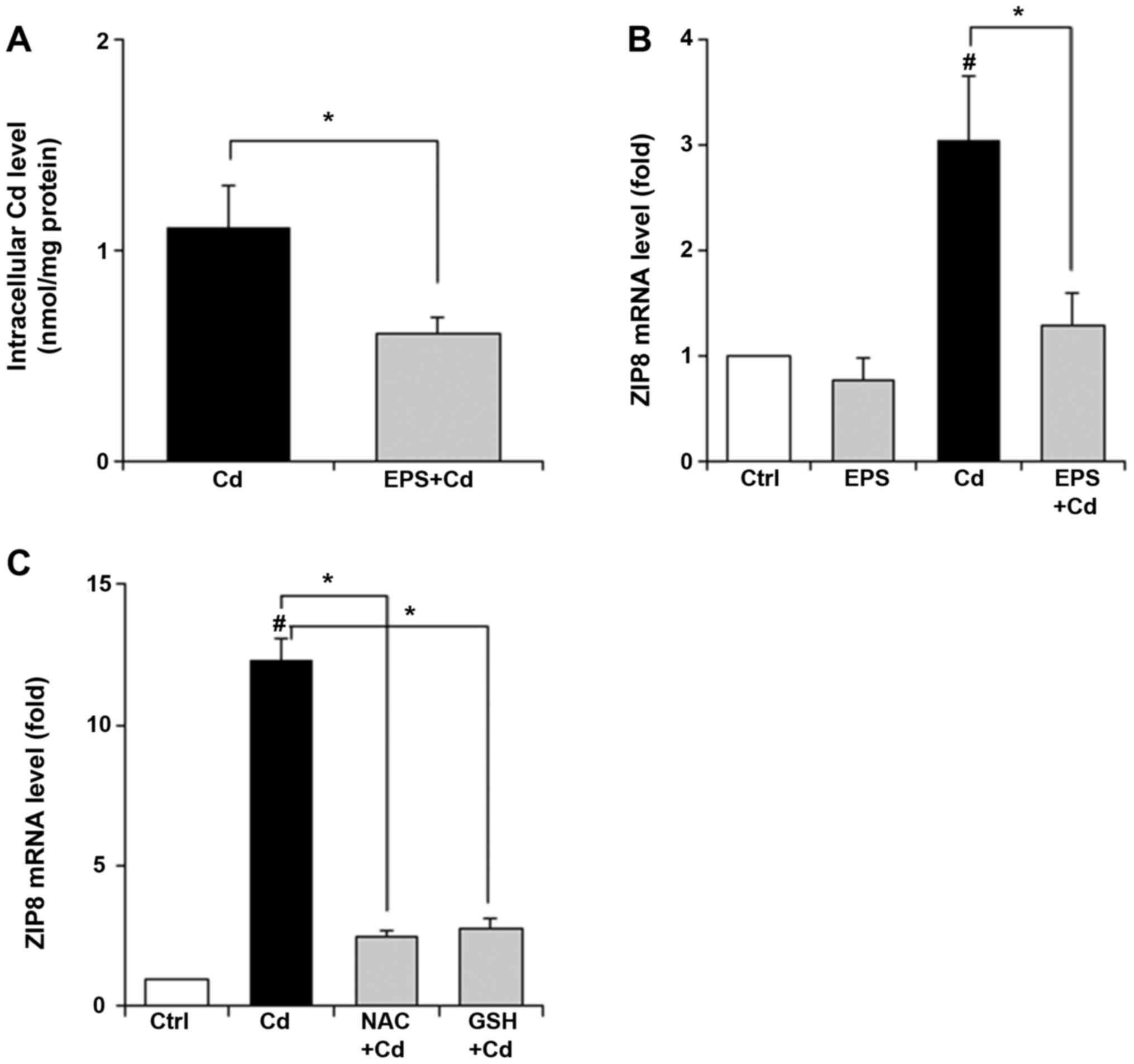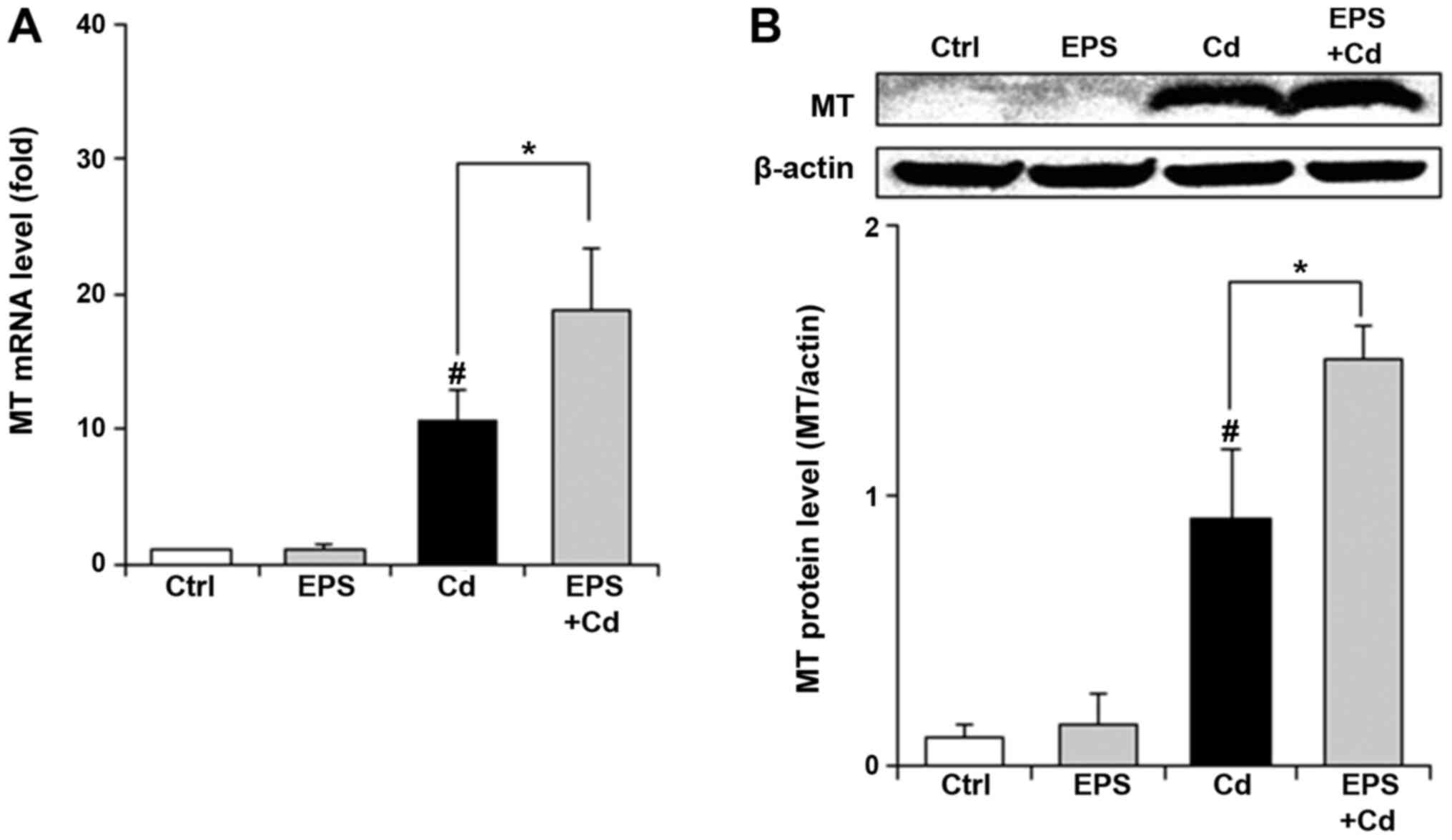|
1
|
Prozialeck WC, Edwards JR, Nebert DW,
Woods JM, Barchowsky A and Atchison WD: The vascular system as a
target of metal toxicity. Toxicol Sci. 102:207–218. 2008.PubMed/NCBI View Article : Google Scholar
|
|
2
|
Shinkai Y, Kimura T, Itagaki A, Yamamoto
C, Taguchi K, Yamamoto M, Kumagai Y and Kaji T: Partial
contribution of the Keap1-Nrf2 system to cadmium-mediated
metallothionein expression in vascular endothelial cells. Toxicol
Appl Pharmacol. 295:37–46. 2016.PubMed/NCBI View Article : Google Scholar
|
|
3
|
Zhai Q, Narbad A and Chen W: Dietary
strategies for the treatment of cadmium and lead toxicity.
Nutrients. 7:552–571. 2015.PubMed/NCBI View Article : Google Scholar
|
|
4
|
Nair AR, Degheselle O, Smeets K, Van
Kerkhove E and Cuypers A: Cadmium-induced pathologies: Where is the
oxidative balance lost (or Not)? Int J Mol Sci. 14:6116–6143.
2013.PubMed/NCBI View Article : Google Scholar
|
|
5
|
Aiba I, Hossain A and Kuo MT: Elevated GSH
level increases cadmium resistance through down-regulation of
Sp1-dependent expression of the cadmium transporter ZIP8. Mol
Pharmacol. 74:823–833. 2008.PubMed/NCBI View Article : Google Scholar
|
|
6
|
Sun Z, Niu Z, Wu S and Shan S: Protective
mechanism of sulforaphane in Nrf2 and anti-lung injury in ARDS
rabbits. Exp Ther Med. 15:4911–4915. 2018.PubMed/NCBI View Article : Google Scholar
|
|
7
|
Yang SH, Long M, Yu LH, Li L, Li P, Zhang
Y, Guo Y, Gao F, Liu MD and He JB: Sulforaphane prevents testicular
damage in Kunming mice exposed to cadmium via activation of
Nrf2/ARE signaling pathways. Int J Mol Sci.
17(E1703)2016.PubMed/NCBI View Article : Google Scholar
|
|
8
|
Alkharashi NAO, Periasamy VS,
Athinarayanan J and Alshatwi AA: Sulforaphane mitigates
cadmium-induced toxicity pattern in human peripheral blood
lymphocytes and monocytes. Environ Toxicol Pharmacol. 55:223–239.
2017.PubMed/NCBI View Article : Google Scholar
|
|
9
|
Sandbichler AM and Höckner M: Cadmium
protection strategies--a hidden trade-off? Int J Mol Sci.
17(E139)2016.PubMed/NCBI View Article : Google Scholar
|
|
10
|
Steele JW, Faulds D and Goa KL:
Epalrestat. A review of its pharmacology, and therapeutic potential
in late-onset complications of diabetes mellitus. Drugs Aging.
3:532–555. 1993.PubMed/NCBI View Article : Google Scholar
|
|
11
|
Hotta N, Akanuma Y, Kawamori R, Matsuoka
K, Oka Y, Shichiri M, Toyota T, Nakashima M, Yoshimura I, Sakamoto
N, et al: Long-term clinical effects of epalrestat, an aldose
reductase inhibitor, on diabetic peripheral neuropathy: The 3-year,
multicenter, comparative Aldose Reductase Inhibitor-Diabetes
Complications Trial. Diabetes Care. 29:1538–1544. 2006.PubMed/NCBI View Article : Google Scholar
|
|
12
|
Sato K, Yama K, Murao Y, Tatsunami R and
Tampo Y: Epalrestat increases intracellular glutathione levels in
Schwann cells through transcription regulation. Redox Biol.
2:15–21. 2013.PubMed/NCBI View Article : Google Scholar
|
|
13
|
Yama K, Sato K, Abe N, Murao Y, Tatsunami
R and Tampo Y: Epalrestat increases glutathione, thioredoxin, and
heme oxygenase-1 by stimulating Nrf2 pathway in endothelial cells.
Redox Biol. 4:87–96. 2015.PubMed/NCBI View Article : Google Scholar
|
|
14
|
Luczak MW and Zhitkovich A: Role of direct
reactivity with metals in chemoprotection by N-acetylcysteine
against chromium(VI), cadmium(II), and cobalt(II). Free Radic Biol
Med. 65:262–269. 2013.PubMed/NCBI View Article : Google Scholar
|
|
15
|
Livak KJ and Schmittgen TD: Analysis of
relative gene expression data using real-time quantitative PCR and
the 2(-ΔΔ C(T)) Method. Methods. 25:402–408. 2001.PubMed/NCBI View Article : Google Scholar
|
|
16
|
Tsukamoto M, Tampo Y, Sawada M and Yonaha
M: Paraquat-induced oxidative stress and dysfunction of the
glutathione redox cycle in pulmonary microvascular endothelial
cells. Toxicol Appl Pharmacol. 178:82–92. 2002.PubMed/NCBI View Article : Google Scholar
|
|
17
|
Zhou YJ, Zhang SP, Liu CW and Cai YQ: The
protection of selenium on ROS mediated-apoptosis by mitochondria
dysfunction in cadmium-induced LLC-PK(1) cells. Toxicol In Vitro.
23:288–294. 2009.PubMed/NCBI View Article : Google Scholar
|
|
18
|
Meister A: Selective modification of
glutathione metabolism. Science. 220:472–477. 1983.PubMed/NCBI View Article : Google Scholar
|
|
19
|
Nair PMG, Park SY, Chung JW and Choi J:
Transcriptional regulation of glutathione biosynthesis genes,
γ-glutamyl-cysteine ligase and glutathione synthetase in response
to cadmium and nonylphenol in Chironomus riparius. Environ Toxicol
Pharmacol. 36:265–273. 2013.PubMed/NCBI View Article : Google Scholar
|
|
20
|
Kolluru GK, Tamilarasan KP, Geetha Priya
S, Durgha NP and Chatterjee S: Cadmium induced endothelial
dysfunction: Consequence of defective migratory pattern of
endothelial cells in association with poor nitric oxide
availability under cadmium challenge. Cell Biol Int. 30:427–438.
2006.PubMed/NCBI View Article : Google Scholar
|
|
21
|
Ono Pharmaceutical Co., Ltd.,
Kinedak® Tablets 50 mg. Epalrestat, Package Insert,
Osaka, Japan, 2009.
|
|
22
|
Harabawy AS and Mosleh YY: The role of
vitamins A, C, E and selenium as antioxidants against genotoxicity
and cytotoxicity of cadmium, copper, lead and zinc on erythrocytes
of Nile tilapia, Oreochromis niloticus. Ecotoxicol Environ Saf.
104:28–35. 2014.PubMed/NCBI View Article : Google Scholar
|
|
23
|
El-Boshy ME, Risha EF, Abdelhamid FM,
Mubarak MS and Hadda TB: Protective effects of selenium against
cadmium induced hematological disturbances, immunosuppressive,
oxidative stress and hepatorenal damage in rats. J Trace Elem Med
Biol. 29:104–110. 2015.PubMed/NCBI View Article : Google Scholar
|
|
24
|
Mizuno K, Kume T, Muto C, Takada-Takatori
Y, Izumi Y, Sugimoto H and Akaike A: Glutathione biosynthesis via
activation of the nuclear factor E2-related factor 2
(Nrf2)--antioxidant-response element (ARE) pathway is essential for
neuroprotective effects of sulforaphane and 6-(methylsulfinyl)
hexyl isothiocyanate. J Pharmacol Sci. 115:320–328. 2011.PubMed/NCBI View Article : Google Scholar
|
|
25
|
Jia Y, Lin J, Mi Y and Zhang C: Quercetin
attenuates cadmium-induced oxidative damage and apoptosis in
granulosa cells from chicken ovarian follicles. Reprod Toxicol.
31:477–485. 2011.PubMed/NCBI View Article : Google Scholar
|
|
26
|
Bahar E, Kim JY and Yoon H: Quercetin
attenuates manganese-induced neuroinflammation by alleviating
oxidative stress through regulation of apoptosis, iNOS/NF-κB and
HO-1/Nrf2 pathways. Int J Mol Sci. 18(E1989)2017.PubMed/NCBI View Article : Google Scholar
|
|
27
|
Chen J and Shaikh ZA: Activation of Nrf2
by cadmium and its role in protection against cadmium-induced
apoptosis in rat kidney cells. Toxicol Appl Pharmacol. 241:81–89.
2009.PubMed/NCBI View Article : Google Scholar
|
|
28
|
Park JY and Seo YR: The protective role of
Nrf2 in cadmium-induced DNA damage. Mol Cell Toxicol. 7:61–66.
2011. View Article : Google Scholar
|
|
29
|
Leverrier P, Montigny C, Garrigos M and
Champeil P: Metal binding to ligands: Cadmium complexes with
glutathione revisited. Anal Biochem. 371:215–228. 2007.PubMed/NCBI View Article : Google Scholar
|
|
30
|
Thévenod F and Lee WK: Cadmium and
cellular signaling cascades: Interactions between cell death and
survival pathways. Arch Toxicol. 87:1743–1786. 2013.PubMed/NCBI View Article : Google Scholar
|
|
31
|
Himeno S, Yanagiya T and Fujishiro H: The
role of zinc transporters in cadmium and manganese transport in
mammalian cells. Biochimie. 91:1218–1222. 2009.PubMed/NCBI View Article : Google Scholar
|
|
32
|
Dalton TP, He L, Wang B, Miller ML, Jin L,
Stringer KF, Chang X, Baxter CS and Nebert DW: Identification of
mouse SLC39A8 as the transporter responsible for cadmium-induced
toxicity in the testis. Proc Natl Acad Sci USA. 102:3401–3406.
2005.PubMed/NCBI View Article : Google Scholar
|
|
33
|
Chen L, Ma L, Bai Q, Zhu X, Zhang J, Wei
Q, Li D, Gao C, Li J, Zhang Z, et al: Heavy metal-induced
metallothionein expression is regulated by specific protein
phosphatase 2A complexes. J Biol Chem. 289:22413–22426.
2014.PubMed/NCBI View Article : Google Scholar
|
|
34
|
Murphy BJ, Andrews GK, Bittel D, Discher
DJ, McCue J, Green CJ, Yanovsky M, Giaccia A, Sutherland RM,
Laderoute KR, et al: Activation of metallothionein gene expression
by hypoxia involves metal response elements and metal transcription
factor-1. Cancer Res. 59:1315–1322. 1999.PubMed/NCBI
|
|
35
|
Andrews GK: Regulation of metallothionein
gene expression by oxidative stress and metal ions. Biochem
Pharmacol. 59:95–104. 2000.PubMed/NCBI View Article : Google Scholar
|


















